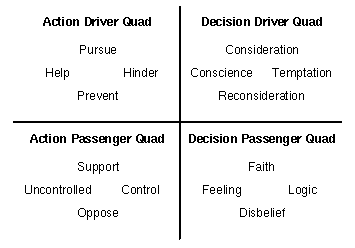A good way to organize character elements is to separate the Action Elements from the Decision Elements. With 16 characteristics, we can create four quads of four characteristics each. This grows from having a Driver Character Quad and a Passenger Character Quad, then splitting each in two (Action Quad and Decision Quad), giving us four Quads: the Action Driver Quad, the Decision Driver Quad, the Action Passenger Quad, and the Decision Passenger Quad.
Motivation Element Quads
Using the Quads to Gain Meaning
In Dramatica, a group of four Quads is called a Set. Note how the set above provides additional meaning. For example, when dealing with a problem of Action in terms of Drivers, one would have the choice to Pursue, Prevent, Help, or Hinder. When a Character represents the Drive to Pursue, it applies itself to achieving the goal. Although it may also want the goal to be achieved, a Help Character focuses its efforts on being useful to the Pursuit of the goal rather than instigating its own effort. This explains the functions of and relationship between the Protagonist’s Drive (Pursue) and the Guardian’s Drive (Help).
Similarly, when a Protagonist’s Drive is Pursue, an Antagonist’s Drive is Prevent. And, of course, the Contagonist Hinders the Protagonist’s Pursuit. In fact, when we consider all four Quads, we can obtain a very precise understanding of why the Eight Archetypal Characters are created as they are and exactly how they relate.
Complex Arrangements of Character Elements
So far we have only explored sixteen different character Elements. One way to create complex characters is by assigning these sixteen Elements to characters in non-archetypal patterns. However, as great as the number of potential characters that can be created is, this limited set of sixteen Elements is still not sufficient to describe all the rich complexities of the Objective Characters we see in sophisticated stories. This is because these sixteen Elements only represent character Motivations. In fact, we call them the Sixteen Motivation Elements.
Characters Do Not Live By Motivations Alone
Like real people, characters are driven by Motivations, but they also aspire to different Purposes, employ different Methodologies in the effort to achieve those purposes, and use different Means of Evaluation to determine the effectiveness of their efforts. The old adage that one should create three
dimensional characters falls short by one dimension. Fully realized characters are four dimensional possessing an Action and Decision Element in each dimension.
From the Dramatica Theory Book


